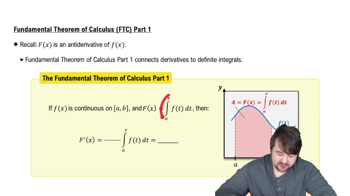If L = √(x² + y²), dx/dt = –1, and dy/dt = 3, find dL/dt when x = 5 and y = 12.
Table of contents
- 0. Functions7h 54m
- Introduction to Functions16m
- Piecewise Functions10m
- Properties of Functions9m
- Common Functions1h 8m
- Transformations5m
- Combining Functions27m
- Exponent rules32m
- Exponential Functions28m
- Logarithmic Functions24m
- Properties of Logarithms36m
- Exponential & Logarithmic Equations35m
- Introduction to Trigonometric Functions38m
- Graphs of Trigonometric Functions44m
- Trigonometric Identities47m
- Inverse Trigonometric Functions48m
- 1. Limits and Continuity2h 2m
- 2. Intro to Derivatives1h 33m
- 3. Techniques of Differentiation3h 18m
- 4. Applications of Derivatives2h 38m
- 5. Graphical Applications of Derivatives6h 2m
- 6. Derivatives of Inverse, Exponential, & Logarithmic Functions2h 37m
- 7. Antiderivatives & Indefinite Integrals1h 26m
- 8. Definite Integrals4h 44m
- 9. Graphical Applications of Integrals2h 27m
- 10. Physics Applications of Integrals 3h 16m
- 11. Integrals of Inverse, Exponential, & Logarithmic Functions2h 31m
- 12. Techniques of Integration7h 41m
- 13. Intro to Differential Equations2h 55m
- 14. Sequences & Series5h 36m
- 15. Power Series2h 19m
- 16. Parametric Equations & Polar Coordinates7h 58m
4. Applications of Derivatives
Related Rates
Problem 3.8.18b
Textbook Question
Diagonals If x, y, and z are lengths of the edges of a rectangular box, then the common length of the box’s diagonals is s = √(x² + y² + z²).
b. How is ds/dt related to dy/dt and dz/dt if x is constant?
 Verified step by step guidance
Verified step by step guidance1
To find how ds/dt is related to dy/dt and dz/dt, we start by differentiating the given formula for the diagonal length s with respect to time t. The formula is s = √(x² + y² + z²).
Since x is constant, its derivative with respect to time, dx/dt, is zero. Therefore, we only need to consider the derivatives of y and z with respect to time.
Apply the chain rule to differentiate s with respect to t: ds/dt = (1/2) * (1/√(x² + y² + z²)) * (2y * dy/dt + 2z * dz/dt).
Simplify the expression: ds/dt = (y * dy/dt + z * dz/dt) / √(x² + y² + z²).
This equation shows how the rate of change of the diagonal length, ds/dt, is related to the rates of change of the edges y and z, dy/dt and dz/dt, respectively, when x is constant.
 Verified video answer for a similar problem:
Verified video answer for a similar problem:This video solution was recommended by our tutors as helpful for the problem above
Video duration:
3mPlay a video:
Was this helpful?
Key Concepts
Here are the essential concepts you must grasp in order to answer the question correctly.
Partial Derivatives
Partial derivatives are used to find the rate of change of a function with respect to one variable while keeping other variables constant. In this problem, since x is constant, we focus on how s changes with respect to y and z, requiring the use of partial derivatives to express ds/dt in terms of dy/dt and dz/dt.
Recommended video:

Derivatives
Chain Rule
The chain rule in calculus is a formula for computing the derivative of a composite function. It is essential here to relate ds/dt to dy/dt and dz/dt, as it allows us to differentiate s = √(x² + y² + z²) with respect to time t, considering y and z as functions of t.
Recommended video:

Intro to the Chain Rule
Pythagorean Theorem in 3D
The formula s = √(x² + y² + z²) is derived from the Pythagorean theorem extended to three dimensions, representing the diagonal of a rectangular box. Understanding this geometric interpretation helps in visualizing how changes in y and z affect the diagonal length s, which is crucial for setting up the relationship between ds/dt, dy/dt, and dz/dt.
Recommended video:

Fundamental Theorem of Calculus Part 1

 4:16m
4:16mWatch next
Master Intro To Related Rates with a bite sized video explanation from Patrick
Start learningRelated Videos
Related Practice
Textbook Question
